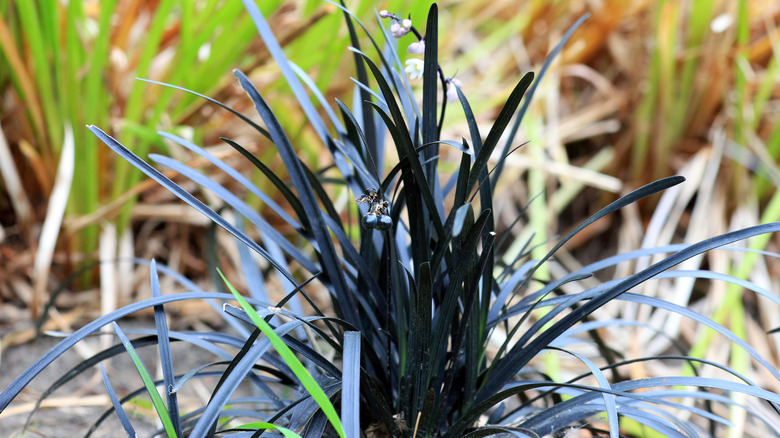The Purple-Black Groundcover That Is Worth The Slow Grow
Ornamental grasses are grown for their vibrant, luxuriant foliage that easily fills a landscape and adds some visual interest to the yard. But while most ornamental grasses come in various shades of green, there's a unique cultivar out there that's out to transform your garden into a more dramatic, eerie setting. The Ophiopogon planiscapus 'Nigrescens' cultivar — commonly known as "black mondo grass" — is an ornamental grass variety whose onyx-color foliage immediately stands out and makes a striking accent wherever you plant it. In fact, Ophiopogon planiscapus 'Nigrescens' is one of the few plants out there that sport a completely black appearance. The only violation of this "dress code" occurs when black mondo grass blooms in the summer, and its stems are adorned with tiny white-purple flowers. As summer winds down, these get replaced by black berries.
Ophiopogon planiscapus 'Nigrescens' is hardy in USDA zones 6a through 9b. This purple-flowering ground cover plant grows in clumps, and its height and width reaches about a foot. It takes black mondo grass a long time to get to these dimensions every year, but the plant's one-of-a-kind appearance makes the slow growth rates well worth the wait. Below, you'll find out how and where to plant black mondo grass in your yard, and how to help this stunning grass thrive.
Where and how to plant black mondo grass
The location you choose for black mondo grass should meet this plant's lighting and soil needs, but also reflect your landscaping design intentions. Fortunately, this cultivar of the Ophiopogon planiscapus isn't all that picky about soil type, and will happily grow in sandy, loamy, and clay soils. However, it does prefer a substrate that's slightly acidic-to-neutral, with an ideal pH of 6.0 to 8.0.
To create ideal lighting conditions, find a sunny spot that provides the plants with six hours of sun per day. Alternatively, a location with partial shade should do. With these necessities out of the way, consider the visual interest black mondo grass will add to your landscape. For example, given the deep black color of this plant's foliage, it's a great option for planting alongside light-colored ornamental grasses. These may include Elijah Blue Fescue, gold Japanese forest grass, and other mondo cultivars.
Once you've picked a spot in the yard, prepare the soil by getting rid of weeds and loosening the substrate as far down as 10 inches beneath the surface. Next, immerse the bare root plants you get at the nursery in a container with water for several hours. As the roots rehydrate, dig holes at least 9 inches apart, and deep enough to accommodate the roots. Finally, place the roots in the soil, making sure that the crown is flush with the surface before backfilling and watering the plants.
Ongoing care instructions for black mondo grass
Freshly transplanted Ophiopogon planiscapus seedlings should get watered regularly before they reach maturity. The soil should be moist but not overwatered at all times, and infrequent, deep waterings are ideal. Their frequency should depend on how quickly the soil dries out. However, as the plant matures, irrigating it a single time weekly should suffice unless your region is undergoing a period of intense heat or drought in the summer. As cold weather sets in, these perennials will die down to the roots. You should protect the roots from chilly winter temperatures by placing a layer of much over them.
Note that mulching Ophiopogon planiscapus is essential not just in winter. Mulch helps keep the surrounding soil weed-free, so your black mondo grass can get all the water and nutrients it needs to thrive without having to compete. Fertilization also helps this plant thrive, but take care not to overfeed it and use a slow-release fertilizer instead of a quick-release one. Fortunately, black mondo grass is quite resilient against pests, and you shouldn't experience issues with insects, deer, or rabbits. Slugs are the sole exception, so you'll need to check your black mondo beds for signs of these critters and remove them as needed.


